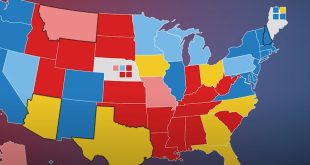Under orders from the Supreme Court to produce a voting map that no longer illegally dilutes the power of Black voters in Alabama, the state’s lawmakers are now facing a high-stakes scramble to come up with an acceptable replacement by the end of this week.
A little over a month after the court’s surprise ruling, the Alabama legislature will convene for a special five-day session on Monday, with the Republican supermajority having given little public indication of how it plans to fulfill a mandate to craft a second district that allows Black voters to elect a representative of their choice — one who could well be a Democrat.
The effects of the revised map, which must be passed by Friday and approved by a federal court, could reverberate across the country, with other states in the South confronting similar voting rights challenges and Republicans looking to hold onto a razor-thin majority in the U.S. House of Representatives next year.
The session also comes at a pivotal moment in the debate over the constitutionality of factoring race into government decisions, as conservatives have increasingly chipped away at the 1965 Voting Rights Act and other longstanding judicial protections centered on equality and race.
“The eyes of the nation are looking at you,” Evan Milligan, one of several Alabama residents who had challenged the legality of the map, told lawmakers during a committee hearing in Montgomery on Thursday. “If you can cut out the noise, look within — you can look to history, you can make a mark in history that will set a standard for this country.”
Alabama has a long list of bitter disputes over the enforcement of the Voting Rights Act, a landmark law born out of the civil rights movement whose key provisions were gutted by a 2013 Supreme Court decision. Litigation forced the creation of Alabama’s first majority-Black congressional district in 1992, and the seat has been represented by a Black Democrat ever since then.
But the current fight stems from lawsuits filed to oppose the map drawn after the 2020 census. In a state where 27 percent of the population is Black, the Republican-controlled legislature packed nearly a third of the Black population into that one district. The state’s remaining six districts each elected a white Republican.
There is little disagreement that voting in Alabama is highly polarized, but lawyers for the state legislature attributed the situation to politics rather than race. (The Supreme Court ruled in 2019 that a gerrymander that discriminates against one party’s voters is a political problem, not a legal one.)
“Black Alabamians’ ‘candidates of choice’ tend to lose elections in Alabama not because they are Black or because they receive Black support, but because they are Democrats,” the state’s lawyers wrote.
And with about 80 percent of Black voters in Alabama identifying as Democrats or leaning toward Democratic candidates, according to the Pew Research Center, “that just makes them easy prey in terms of redistricting,” said Seth C. McKee, a University of Oklahoma professor who has written about political realignment in the South. “And once Republicans get control, it’s just difficult for them not to dominate.”
But a federal panel of three judges unanimously said the map had most likely violated the Voting Rights Act and ordered it redrawn, four months before the 2022 primary elections. The Supreme Court, while agreeing to consider the challenge, allowed the map to go into effect ahead of the November elections.
Many experts expected the Supreme Court to say in the Alabama case what it essentially said in its decision outlawing affirmative action in education: Making allowances to remedy discrimination against one group inevitably ends up discriminating against other groups.
However, in June, the court narrowly upheld Section 2 of the Voting Rights Act, the principal remaining clause of the law, which outlaws any election law or rule that discriminates based on race, color or language. That decision has already had ramifications elsewhere: a similar lawsuit is now moving forward in Louisiana, while voting rights advocates in Georgia have begun sparring with the state over whether the ruling affects similar lawsuits there.
“We’re already showing how this opinion is going to have ripple effects,” said Abha Khanna, who represented some of the Alabama plaintiffs as the head of the Elias Law Group’s redistricting practice. She added, “You are sending a message to states and jurisdictions.”
The Alabama legislature now has until Friday to create another map that gains approval from a federal court, and has solicited public proposals. Should the legislature fall short, the map could again be challenged, leaving open the possibility that the court would draw its own map and cut out the legislature altogether.
“It is critical that Alabama be fairly and accurately represented in Washington,” said Gov. Kay Ivey, a Republican, as she formally summoned the legislature back for the special session. “Our legislature knows our state better than the federal courts do.”
But it leaves Republicans with a task that could jeopardize the electoral security of one of their own in Congress. The nonpartisan Cook Political Report now marks the once solidly Republican First and Second Congressional Districts as toss-ups, citing “the presumption that one of their seats will ultimately become a Montgomery and Mobile-based Black majority seat that comfortably elects a Democrat.”
On Thursday, multiple Black Republicans spoke during the committee hearing, including Belinda Thomas, a Dale County councilwoman and Republican Party official who later described herself as “living proof” that the current map made it possible for Black candidates to succeed. Some residents and officials also raised concerns about diminishing the representation of rural communities and economic opportunity under some of the proposed maps.
Democrats appeared divided over which plan to back, with some lawmakers supporting one that relies on a combination of traditionally Democratic voting blocs to create a new district in order to avoid drawing on racial lines. At least one of the plaintiffs wore a T-shirt emblazoned with their preferred map, which would enshrine the 18 counties of Alabama’s Black Belt, the stretch of historically rich soil that fueled cotton plantations worked by slave labor, into two districts with at least 50 percent of the Black voting population.
“I want myself and my community to have a seat at the table, rather than be on the menu,” said Shalela Dowdy, a Mobile resident and one of the plaintiffs.
But notably absent from the public discussion on Thursday was any plan backed by the Republican supermajority. State Representative Chris Pringle, a Republican from Mobile, said that a final map would be shared before a committee meeting on Monday, although Democrats balked at being left out of the process and at the public getting little time to review a final plan.
“This is a really tortured process,” said State Representative Chris England, a Democrat from Tuscaloosa. He added that “everybody else has been presenting the maps that they believe best represent the state of Alabama, give everybody an opportunity to be represented, but the supermajority has not.”
Mr. Pringle said that the committee tasked with overseeing the creation of the new map had been overwhelmed with a number of submissions, including from as far away as France and New Zealand. A little over a dozen had been made public online or in a hearing, with Mr. England sharing a few more maps circulated among the committee on Twitter on Friday evening.
“We have been pretty much overwhelmed,” Mr. Pringle said.
Adam Liptak contributed reporting from Washington. Susan C. Beachy contributed research.
 Top Naija News: Nigerian News, Breaking News Nigeria and World News Top Naija News is a daily news publication in Nigeria, delivering the latest breaking news in Nigeria and around the world.
Top Naija News: Nigerian News, Breaking News Nigeria and World News Top Naija News is a daily news publication in Nigeria, delivering the latest breaking news in Nigeria and around the world.



